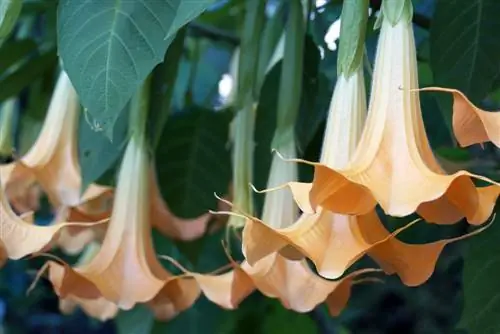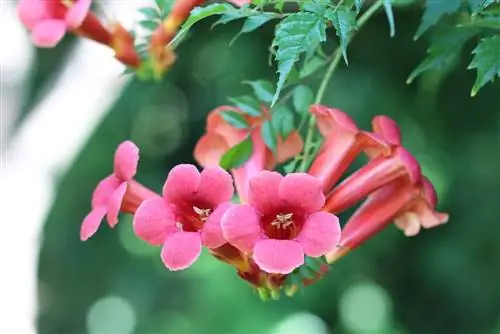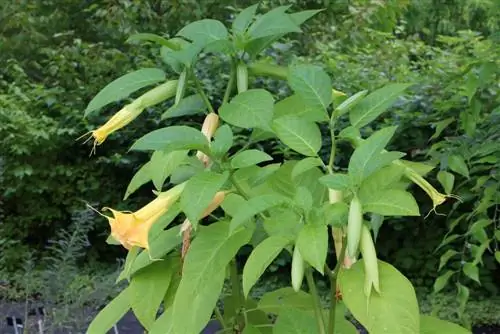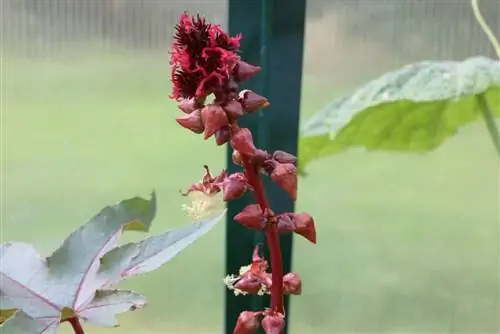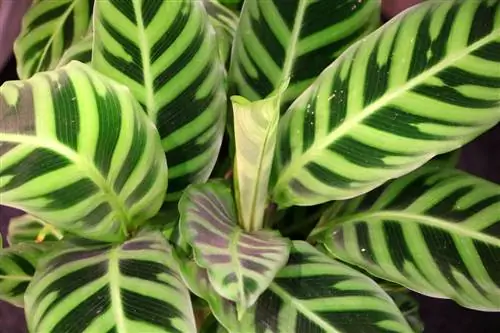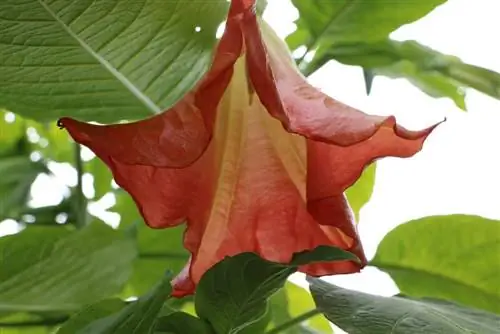- Author admin [email protected].
- Public 2023-12-17 03:39.
- Last modified 2025-01-24 12:45.
The angel's trumpet enchants the viewer in summer with its huge flowers. The angel trumpet originally comes from Brazil. Brugmansia, its botanical name, is not hardy and is therefore cultivated as a pot plant. In groups or as a solitary plant, it is a breathtaking eye-catcher for the garden, balcony or terrace. Their outdoor season is from mid-May to October. In any case, it must be brought into its winter quarters before the first frost. Brugmansia needs to be supplied with plenty of water and nutrients in summer so that it can produce its beautiful flowers. Botanically, the angel's trumpet belongs to the nightshade family.
But be careful: all parts of the plant are poisonous.
Location & plant substrate
The angel's trumpet loves the sun, but direct midday sun should be avoided. If it is permanently in partial shade, it will not bloom as profusely as in sunny locations. She also prefers a location protected from the wind. A place on the house wall gives it additional warmth on warm summer nights.
- Sunny to full sun
- Morning and evening sun
- Protect from the wind, tie to a pole if necessary
- Commercial potting soil
- Enrichment with around 10 percent clay granules and expanded clay as nutrient and water storage
Tip:
The angel's trumpet is happy about shady trees in the midday heat. A parasol can also serve as a tree replacement.
Solitary or in a neighborhood?
Brugmansia quickly reaches an impressive size and attracts full attention with its impressive flowers. It therefore comes into its own best as a solitary plant. To showcase your flowers even better, a high-contrast location, for example in front of a hedge, is recommended. Other flowering plants such as marigolds, geraniums or lavender support the frequent bloomer.
Plants
Angel trumpets like to live large. If the pot or bucket is too small, the water-loving plants will quickly let their leaves droop and the splendor of flowers will soon be over. In order to provide the angel trumpet with enough space, the following points should be taken into account:
- Repotting young plants after wintering
- The new pot or bucket should be around three centimeters larger.
- Remove dead roots
- Good water drainage at the bottom of the pot with or without a saucer
- For large plants, ensure the necessary stability as they easily tip over in wind
- Provide the tub with a drainage layer made of pottery shards, expanded clay or gravel
- Planting depth: no deeper than when purchased or in the old bucket or pot
Tip:
Plastic pots are better than clay or terracotta containers. Fine roots cannot grow on plastic walls and the pots are better rooted. Masonry buckets are recommended for large angel trumpets. But provide these with drainage holes before planting.
Planting out in the garden
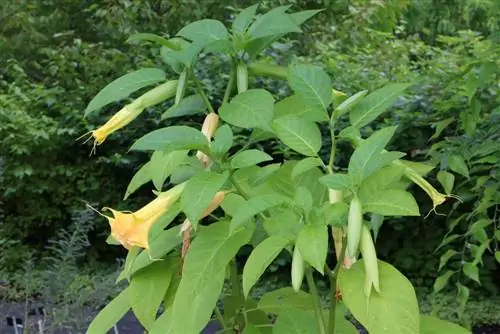
Angel trumpets can be planted in the garden for the outdoor season. The plants that are not hardy must then be moved into a bucket for winter quarters before the first frost. The plant tolerates cutting off the roots well. However, the bucket should not be too small.
Watering & Fertilizing
The angel's trumpet is a heavy feeder, and its large leaves mean that water evaporation is very high. So their water and nutrient needs are enormous. That's why the plant needs a large container that can hold a lot of water. It also needs to be fertilized regularly and often. It is hardly possible to over-fertilize the plant. When watering and fertilizing, the following should be observed:
- Lots of water, water twice on hot days (morning and evening)
- Pour until the water comes out of the drain holes
- Avoid waterlogging
- Wait until the soil dries
- Supplement soft irrigation water with algae lime
- When repotting in spring, enrich the new soil with a slow-release fertilizer for potted plants
- Add a liquid fertilizer to the irrigation water once or twice a week from May to August
- Stop fertilizing from the end of August
Tip:
Twice the amount of fertilizer is just right for the angel's trumpet. If the front part of the leaves becomes light, the plant suffers from a lack of nutrients.
Leaves, flowers & growth
The angel trumpet impresses with its large, magnificent flowers. The trees or bushes sometimes grow to a height of several meters. The Brugmansia has a flowering and a growing area. Flowers only form in the flowering area. This can be recognized by its asymmetrical leaves. The leaves are symmetrical in the growing area. The large leaves have petioles several centimeters long and can be up to 25 centimeters long and 10 centimeters wide. The shape of the leaves varies slightly from variety to variety. They can be ovoid or ovoid-elliptical or even elongated.
Typically, angel trumpets grow 50 to 100 centimeters per year, some varieties even up to 150 centimeters. But there are also weak-growing plants that only grow 30 centimeters per year.
- Large and ovate-elliptical leaves with medium green color
- Large cup-shaped or funnel-shaped flowers on a flower style
- Flowers filled or unfilled
- Flower color: white, yellow to red
- Flowering period from June to September
- Intense scent in the evening
- Tall trees or shrubs
- fast-growing
- Growth height is 2 to 5 meters
Cutting
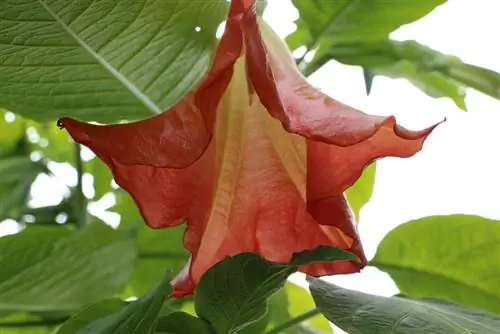
The angel's trumpet is pruned in the fall after flowering so that it can grow stronger again after the winter rest and produce many fresh flower shoots. No further pruning is necessary during the outdoor season. During the flowering period, Brugmansia naturally branches and produces new flower shoots. The flowering shoot sections can be recognized by the asymmetrical leaves. Under no circumstances should you cut the angel's trumpet into the area of the symmetrical leaves, because the plant does not produce any flowers there.
- Cut back to the ideal transport size before wintering
- Leave one asymmetrical leaf per flower shoot
- A radical cut back to the growing area delays flower formation in spring
- After the autumn cut, place the plant in a warm location on the balcony or terrace for a few days to allow the wounds to heal
Tip:
If the angel's trumpet sprouts in the winter quarters, simply cut the thin, few-branched shoots back to one or two leaves.
Wintering
Brugmansia is not hardy and must be brought indoors before the first frost. It is best to cut back before moving to winter quarters. To avoid mold or fungal infestation, the winter quarters should be well ventilated on a regular basis if it is not too cold. Wintering takes place in May after the Ice Saints. After overwintering, Brugmansia first has to get used to the sun again. To allow the plant to acclimatize, it is best to place it in a shady spot for a few days before moving to its summer location. This tactic also prevents the leaves from burning in the sun after overwintering. Alternatively, the plant can be placed in a greenhouse until it hibernates. To overwinter the plant needs:
- A bright winter quarters
- A temperature of 10 to 15 degrees Celsius
- Continuing to bloom in winter quarters is possible for a while
- Water regularly but moderately
- Avoid waterlogging
- The root ball should not dry out
- Regular inspection for pest infestation
- Do not overwinter young plants in the dark
Wintering in the dark
Brugmansia also overwinters in the dark. In this case, the temperature should be constantly around 5 degrees Celsius. The plant then loses all of its leaves, but sprouts again in spring. Even when overwintering in the dark, the root ball must not dry out. However, the plant should be watered less than when overwintering in a bright location. Regular ventilation must also be ensured when overwintering in the dark.
Propagate
The angel trumpet can be propagated with seeds or cuttings. The best time for propagation with cuttings is between April and July. Herbaceous parts from the shoot tips of the plant or woody parts are recommended. The cut parts should be approx. 20 centimeters long. They are simply inserted into the potting soil and should always be kept moist. At an air temperature of 18 to 20 degrees, the cuttings develop roots after two to three weeks. Once the first roots have formed, immediately move the young plants into larger pots with conventional potting soil.
When propagated with seeds, these are harvested from the flowers of the angel's trumpet in autumn. Then store the dried seeds until sowing in spring. At temperatures around 20 degrees, the seeds are placed in small pots with sowing soil. Simply place a foil bag or a glass over the pot with the seeds. As with propagation with cuttings, the young plants can then be moved into larger pots after two to three weeks.
In the best case scenario, the young plants produce their first flowers in early autumn.
Diseases & Pests

Fungals and root rot are among the most common diseases of angel trumpet. A number of pests have also taken a liking to the plant. In addition, the plant can quickly suffer from a lack of water and nutrients in summer. Pests are not only a danger during the outdoor season, unfortunately they can also nest in the winter.
- Root rot can occur if waterlogging occurs
- Infestation of weevils possible
- Leave feeding marks on the leaves
- Collect beetles immediately and fight larvae
- Snails also like the leaves very well
- Infestation by various pests, especially spider mites possible in dry summers
- Start countermeasures immediately
Toxicity
The angel's trumpet belongs to the nightshade family and is therefore poisonous in all parts. Small children in particular should be kept away from the plant. Caution is also advised with pets. However, the large flowers are more inviting to admire than to eat. To avoid coming into contact with its juices when working with the plant, gardening gloves should always be used.
Symptoms of poisoning include vomiting and diarrhea, visual disturbances and hallucinations. If symptoms occur, you should go to a clinic. Sensitive people should avoid placing the plant in the bedroom or in front of the bedroom, as they can react to the scent of the angel trumpet with skin irritation, headaches or nausea.
Interesting facts about the angel trumpet
The angel trumpet originally comes from South America. In nature it quickly grows up to five meters high. There are now a wide variety of varieties of Brugmansia available in specialist stores, which, in addition to the flower color, also differ in height and speed of growth.
Conclusion
The angel trumpet is an impressive and beautiful plant that impresses with its large flowers and leaves. After wintering out in mid-May, depending on the variety, it delights the gardener with its white to red cup-shaped flowers. In the evening it exudes an intense scent. As a heavy feeder, the angel's trumpet needs a lot of water and plenty of nutrients during the outdoor season. However, it still cannot tolerate waterlogging. A bucket with drainage holes is therefore an advantage. Before the first frost, the non-hardy Brugmansia must be brought indoors. Before that it should be cut back. The angel's trumpet hibernates in both light and darkness. During winter rest it should not be fertilized and only watered moderately so that the root ball does not dry out. Good ventilation and regular checking for pest infestation are particularly important when overwintering. Brugmansia is propagated via cuttings or seeds, which take root in the pot after two to three weeks. And please remember: The attractive plant is poisonous, so don't forget your gloves when working.

